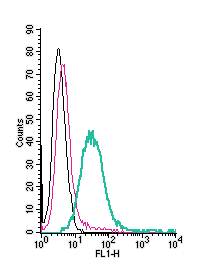Overview
- Peptide (C)RSYSTTYEERNITGTR, corresponding to amino acid residues 202 - 217 of human ASCT2 (Accession Q15758). 2nd extracellular loop.

 Cell surface detection of ASCT2 by direct flow cytometry in live intact human Jurkat T-cell leukemia cells:___ Cells.
Cell surface detection of ASCT2 by direct flow cytometry in live intact human Jurkat T-cell leukemia cells:___ Cells.
___ Cells + Rabbit IgG Isotype Control-FITC (#RIC-001-F).
___ Cells + Anti-Human ASCT2/SLC1A5 (extracellular)-FITC Antibody (#ANT-083-F), (2.5µg). Cell surface detection of ASCT2 by direct flow cytometry in live intact human K562 chronic myeloid leukemia cells:___ Cells.
Cell surface detection of ASCT2 by direct flow cytometry in live intact human K562 chronic myeloid leukemia cells:___ Cells.
___ Cells + Rabbit IgG Isotype Control-FITC (#RIC-001-F).
___ Cells + Anti-Human ASCT2/SLC1A5 (extracellular)-FITC Antibody (#ANT-083-F), (5µg). Cell surface detection of ASCT2 by direct flow cytometry in live intact human HL-60 promyelocytic leukemia cells:___ Cells.
Cell surface detection of ASCT2 by direct flow cytometry in live intact human HL-60 promyelocytic leukemia cells:___ Cells.
___ Cells + Rabbit IgG Isotype Control-FITC (#RIC-001-F).
___ Cells + Anti-Human ASCT2/SLC1A5 (extracellular)-FITC Antibody (#ANT-083-F), (5µg).
- Kasai, N. et al. (2017) Am. J. Transl. Res. 9, 3399.
- Marshall, A.D. et al. (2017) Oncogenesis 6, e367.
- Dong, J. et al. (2017) Oncogenesis 6, e356.
ASCT2 is an alanine-serine-cysteine amino acid transporter and solute linked carrier family 1 member A5 (SLC1A5). It functions as an essential high-affinity glutamine transporter. It also functions as a Na+-dependent transporter for alanine, serine and cysteine. The transport process is electroneutral which involves the Na+-coupled influx of glutamine to the Na+-coupled efflux of another substrate such as alanine, serine or cysteine. ASCT2 is expressed various peripheral tissues such as the lung and kidney1,2. ASCT2 has an important contribution to the homeostasis of amino acid metabolism within tumor cells3.
ASCT2 seems to be up regulated in several cancerous tissues such as stomach, liver, kidney, breast, prostate, skin, colorectal, pancreatic, tongue and lung cancers. Studies have shown that ASCT2 is necessary for activating critical survival and cellular growth signaling cascades in cancer, which includes mTOR and ERK pathways. It has been shown that knockdown of ASCT2 in prostate cancer cell line xenograft models significantly inhibit tumor growth and metastasis in vivo. Thus, ASCT2 is a potential cancer therapeutic target1,2.
Application key:
Species reactivity key:
Anti-Human ASCT2/SLC1A5 (extracellular) Antibody (#ANT-083) is a highly specific antibody directed against an extracellular epitope of the human protein. The antibody can be used in western blot and live cell flow cytometry applications. It has been designed to recognize SLC1A5 from human samples only. The antibody will not recognize rat or mouse ASCT2.
Anti-Human ASCT2/SLC1A5 (extracellular)-FITC Antibody (#ANT-083-F) is directly conjugated to fluorescein isothiocyanate (FITC) fluorophore. This conjugated antibody has been developed to be used in immunofluorescent applications such as direct flow cytometry and live cell imaging. It has been designed to recognize SLC1A5 from human samples only. The antibody will not recognize rat or mouse ASCT2.
